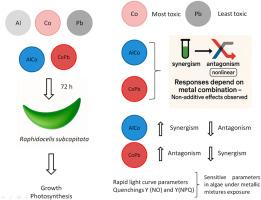Exposure to metals and metallic mixtures at environmental concentrations impairs photosynthesis and microalgal biomass production: A lab study with Raphidocelis subcapitata (Chlorophyceae)
IF 5.8
2区 生物学
Q1 AGRICULTURAL ENGINEERING
引用次数: 0
Abstract
In the environment, microalgae are exposed to several stressors, including metals. These stressors affect the algal metabolism (e.g., growth, photosynthesis, biochemical composition) and can alter the quality (mainly in terms of lipids, fatty acids, carbohydrates) and the quantity of algal biomass produced. These alterations can be beneficial, e.g., due to the presence of a stressor, algae can produce more lipids, which can be useful for biotechnological purposes. However, finding the exact combination and/or concentration of stressors that stimulates algal production is still a huge challenge. In the present study, we evaluated how environmental concentrations of cobalt (Co, essential metal), aluminum, and lead (Al and Pb, non-essential metals), isolated and in combination (Co + Al and Co + Pb), affect the growth and photosynthesis of the microalga Raphidocelis subcapitata. Isolated, Co and Al negatively affected growth and photosynthetic parameters, while Pb did not impact them. Growth was the most sensitive parameter evaluated under mixture, while the decrease of non-photochemical quenchings indicates damage to the photoprotection mechanisms of algae in the presence of multiple stressors, especially in Co + Al. Given that the evaluated concentrations of Co, Al, and metallic mixtures negatively impacted growth and compromised carbon assimilation by algae, we recommend conducting further studies to assess the biochemical composition of algae exposed to environmental concentrations of metals and mixtures. This will enhance our understanding of changes in algal metabolism and help define better strategies for increasing carbon assimilation and biomass production, which could be beneficial for biotechnological applications and phytoremediation efforts.

暴露在环境浓度的金属和金属混合物中会损害光合作用和微藻生物量的产生:对亚capitata Raphidocelis(绿藻科)的实验室研究
在环境中,微藻暴露于几种压力源,包括金属。这些应激源影响藻类的代谢(如生长、光合作用、生化组成),并能改变藻类生物量的质量(主要是脂类、脂肪酸、碳水化合物)和数量。这些变化可能是有益的,例如,由于压力源的存在,藻类可以产生更多的脂质,这对于生物技术目的是有用的。然而,找到刺激藻类生长的压力源的确切组合和/或浓度仍然是一个巨大的挑战。在本研究中,我们评估了环境浓度的钴(Co,必需金属),铝和铅(Al和Pb,非必需金属),分离和组合(Co + Al和Co + Pb)如何影响微藻Raphidocelis subcapitata的生长和光合作用。Co和Al对其生长和光合参数有负面影响,Pb对其生长和光合参数无显著影响。在混合条件下,生长是最敏感的参数,而非光化学猝灭的减少表明在多种胁迫条件下藻类的光保护机制受到损害,特别是Co + Al。考虑到所评估的Co、Al和金属混合物浓度对藻类的生长和碳同化产生负面影响,我们建议进行进一步的研究,以评估藻类暴露于环境浓度的金属和混合物的生化成分。这将增强我们对藻类代谢变化的理解,并有助于确定更好的策略来增加碳同化和生物量生产,这可能有利于生物技术应用和植物修复工作。
本文章由计算机程序翻译,如有差异,请以英文原文为准。
求助全文
约1分钟内获得全文
求助全文
来源期刊

Biomass & Bioenergy
工程技术-能源与燃料
CiteScore
11.50
自引率
3.30%
发文量
258
审稿时长
60 days
期刊介绍:
Biomass & Bioenergy is an international journal publishing original research papers and short communications, review articles and case studies on biological resources, chemical and biological processes, and biomass products for new renewable sources of energy and materials.
The scope of the journal extends to the environmental, management and economic aspects of biomass and bioenergy.
Key areas covered by the journal:
• Biomass: sources, energy crop production processes, genetic improvements, composition. Please note that research on these biomass subjects must be linked directly to bioenergy generation.
• Biological Residues: residues/rests from agricultural production, forestry and plantations (palm, sugar etc), processing industries, and municipal sources (MSW). Papers on the use of biomass residues through innovative processes/technological novelty and/or consideration of feedstock/system sustainability (or unsustainability) are welcomed. However waste treatment processes and pollution control or mitigation which are only tangentially related to bioenergy are not in the scope of the journal, as they are more suited to publications in the environmental arena. Papers that describe conventional waste streams (ie well described in existing literature) that do not empirically address ''new'' added value from the process are not suitable for submission to the journal.
• Bioenergy Processes: fermentations, thermochemical conversions, liquid and gaseous fuels, and petrochemical substitutes
• Bioenergy Utilization: direct combustion, gasification, electricity production, chemical processes, and by-product remediation
• Biomass and the Environment: carbon cycle, the net energy efficiency of bioenergy systems, assessment of sustainability, and biodiversity issues.
 求助内容:
求助内容: 应助结果提醒方式:
应助结果提醒方式:


